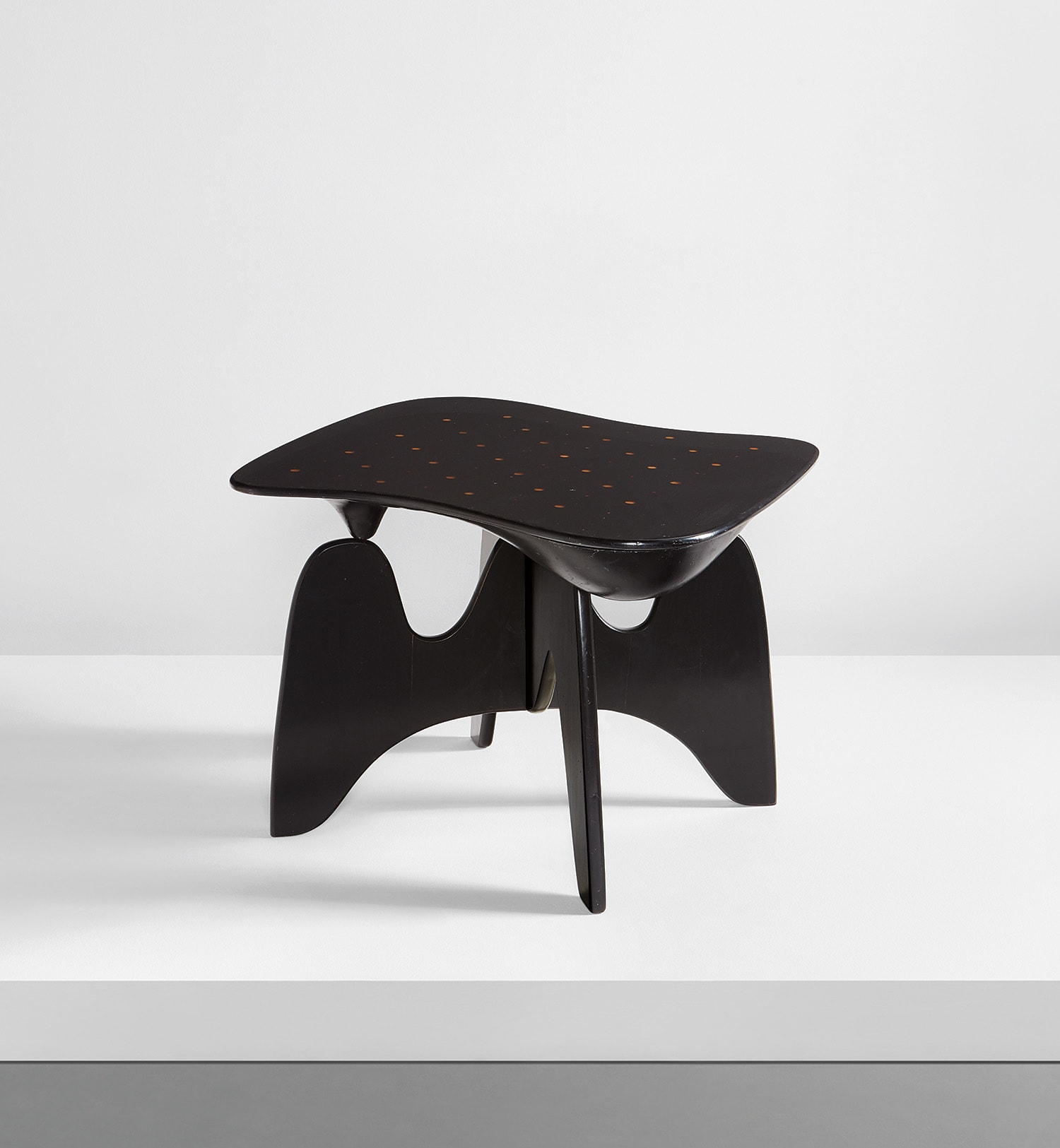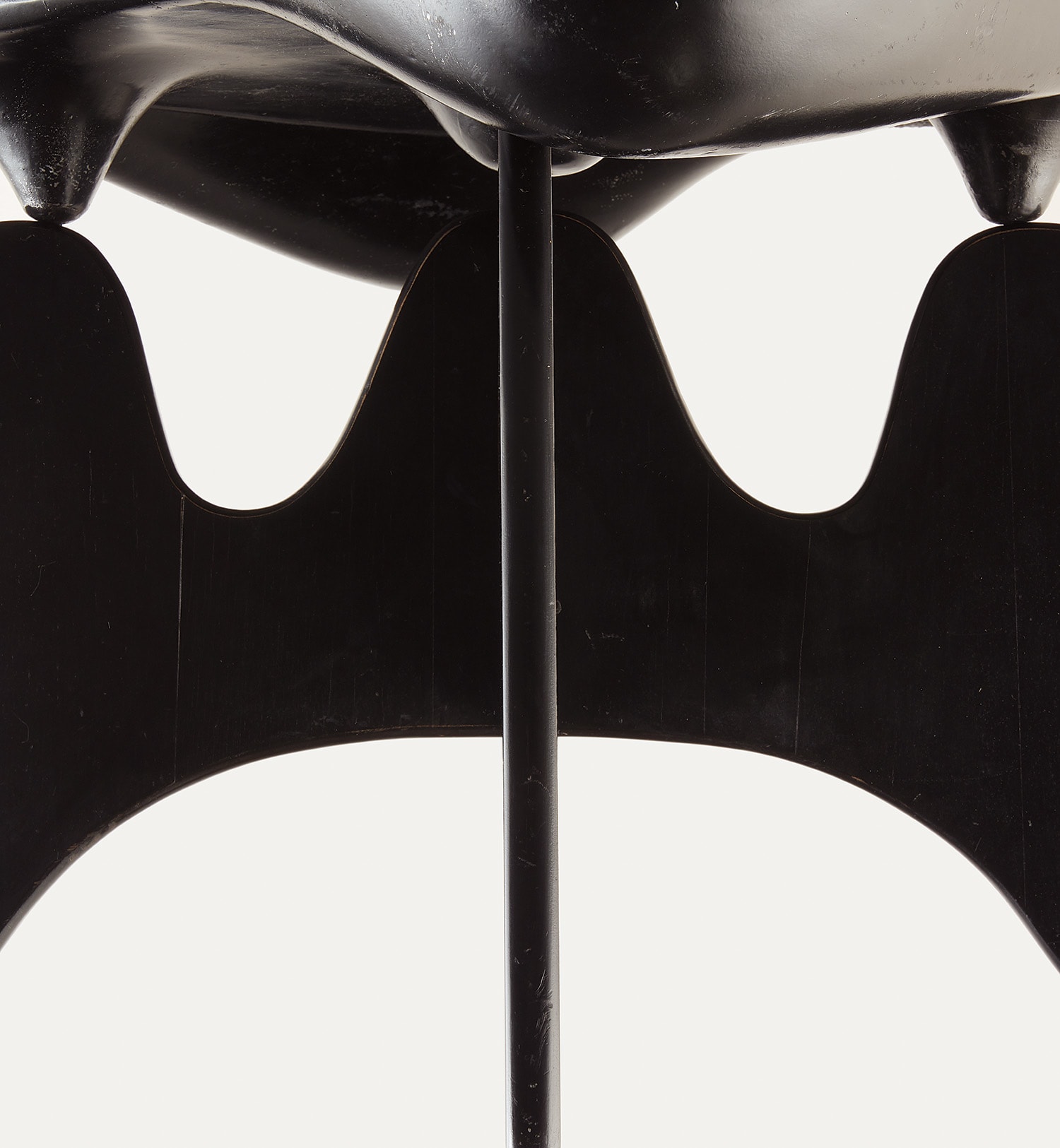







Property from a Private Collection, Florida
94
Isamu Noguchi
Rare chess table, model no. IN-61
circa 1947
Ebonized plywood, painted cast aluminum, acrylic inlays.
18 3/4 x 24 x 24 in. (47.6 x 61 x 61 cm)
Produced by The Herman Miller Furniture Company, Zeeland, Michigan.
Full-Cataloguing
Playing With Form: A Sculptural Chess Table by Isamu Noguchi
by Luke T. Baker
Throughout his sixty-year career, Isamu Noguchi eluded creative categorization, working as a sculptor, set designer, landscape artist, and a designer of light fixtures, furnishings, interiors, and consumer goods. Noguchi didn’t subscribe to any one aesthetic school or believe in boundaries between fine and applied arts, writing in a 1936 treatise that sculptors and painters “should not forever be concerned with pure art or meaningful art, but should inject their knowledge of form and matter into the everyday, usable designs of industry and commerce.” To that end, Noguchi approached his product and furniture designs with the same humanistic sensualism and graceful monumentality of his sculptural works, creating some of the most enduring icons of modern design, including his Radio Nurse baby monitor system from 1933, and his IN-50 coffee table, designed in 1944 and still in production today. As a holistic extension of his sculptural practice, Noguchi would often incorporate the same forms, materials, and techniques in his design projects, effectively creating scalable, functional sculptures for the domestic sphere.
The present lot, the rare IN-61 chess table, is an object that intentionally blurs the line between design and sculpture. Originally conceived as a functional artwork, the table was designed in 1944 for the seminal Surrealist exhibition, The Imagery of Chess, organized by Marcel Duchamp and Max Ernst, and held at the eponymous Midtown gallery of Julien Levy, a friend and patron of Noguchi’s. From December 1944 through January of the following year, the table was displayed alongside chess‐inspired works by fellow members of Noguchi’s Avant Garde coterie of artists and intellectuals, among them Andre Breton, John Cage, Alexander Calder, Yves Tanguy, and Frederick Kiesler.
Noguchi’s design does away with the rigid formalism of the traditional chess board, softening its lines with his signature biomorphic organicism. Regular geometries are all but abandoned, and even the rectilinear grid is replaced by a field of inlaid dots of colored plastic. Constructed of veneered plywood—a wartime industrial material—Noguchi treated the table with a lacquer‐like ebonized finish to further emphasize its sculptural silhouette.
The table’s legs, two curvaceous plywood shapes intersecting at a right angle to form a cross‐like support, are directly related to the sculptures and set pieces Noguchi was developing around this period. His suite of sculptural elements for Hérodiade, a production by modern dancer and longtime collaborator Martha Graham, which were designed just a few months earlier, used abstract, flat shapes notched together to create dimensional forms. A set of acetate chess pieces Noguchi designed for the exhibition table also reveal the influence of the of the Hérodiade sets in their similarly expressive forms and notched construction. Noguchi would continue this exploration of interlocking shapes until 1948, creating an important series of sculptures in slabs of marble and slate.
Rotating the tabletop reveals scooped pockets of cast and painted aluminum—clever storage for chess pieces, cards, cigarettes, and other small objects. With its hill‐and‐dale contours, this molded tray bears similarity to the topographical sculptures, interior surfaces, and playground designs Noguchi was working on in the during the 1940s, such as This Tortured Earth, a wartime elegy to a bombed‐out landscape produced in 1943, or his undulating sculptural ceiling for the Time Life Building, designed around 1947.
It was George Nelson, the noted midcentury designer, who would transform this one‐off art object into one of Noguchi’s earliest furniture designs to become available to the public. Nelson was so taken by the chess table upon encountering it the on the exhibition’s opening night that he purchased the piece on the spot, presumably for his personal collection and use. Nelson’s storied affiliation with Herman Miller began soon thereafter when, as design director, he would commence recruiting designs from some of the most important figures of the postwar period, including Ray and Charles Eames, Alexander Girard, and his friend Isamu Noguchi.
Under Nelson’s oversight, Noguchi’s chess table went into commercial production in 1947. Capitalizing on the post‐war boom in casual furnishings for the home, the company shrewdly chose not to market the table for its original highly specialized function (and thus did not reproduce Noguchi’s Surrealistic chess pieces). Instead, it was described as “ideal as a small coffee table,” or even as an intimate dining surface. A publicity photograph from the period also illustrates it in use as a sewing table, its handy metal pockets used as holds for bobbins and other accoutrements. Unfortunately, it was this cast aluminum tray that proved ultimately too costly to manufacture, and in 1949 the design was discontinued.
Noguchi would go on to develop other successful designs, such as the Rudder coffee table for Herman Miller (1949), the Akari paper lamps (beginning in 1951), and the Cyclone series of tables and seating for Knoll (1954). Though his renown grew as more of his furniture went into production, Noguchi never considered himself a designer. “Everything is sculpture,” he asserted in 1949, reinforcing his position that, whether designing a table or an artwork, both are to be approached as “fundamental problems of form that…express human and aesthetic activity.”
by Luke T. Baker
Throughout his sixty-year career, Isamu Noguchi eluded creative categorization, working as a sculptor, set designer, landscape artist, and a designer of light fixtures, furnishings, interiors, and consumer goods. Noguchi didn’t subscribe to any one aesthetic school or believe in boundaries between fine and applied arts, writing in a 1936 treatise that sculptors and painters “should not forever be concerned with pure art or meaningful art, but should inject their knowledge of form and matter into the everyday, usable designs of industry and commerce.” To that end, Noguchi approached his product and furniture designs with the same humanistic sensualism and graceful monumentality of his sculptural works, creating some of the most enduring icons of modern design, including his Radio Nurse baby monitor system from 1933, and his IN-50 coffee table, designed in 1944 and still in production today. As a holistic extension of his sculptural practice, Noguchi would often incorporate the same forms, materials, and techniques in his design projects, effectively creating scalable, functional sculptures for the domestic sphere.
The present lot, the rare IN-61 chess table, is an object that intentionally blurs the line between design and sculpture. Originally conceived as a functional artwork, the table was designed in 1944 for the seminal Surrealist exhibition, The Imagery of Chess, organized by Marcel Duchamp and Max Ernst, and held at the eponymous Midtown gallery of Julien Levy, a friend and patron of Noguchi’s. From December 1944 through January of the following year, the table was displayed alongside chess‐inspired works by fellow members of Noguchi’s Avant Garde coterie of artists and intellectuals, among them Andre Breton, John Cage, Alexander Calder, Yves Tanguy, and Frederick Kiesler.
Noguchi’s design does away with the rigid formalism of the traditional chess board, softening its lines with his signature biomorphic organicism. Regular geometries are all but abandoned, and even the rectilinear grid is replaced by a field of inlaid dots of colored plastic. Constructed of veneered plywood—a wartime industrial material—Noguchi treated the table with a lacquer‐like ebonized finish to further emphasize its sculptural silhouette.
The table’s legs, two curvaceous plywood shapes intersecting at a right angle to form a cross‐like support, are directly related to the sculptures and set pieces Noguchi was developing around this period. His suite of sculptural elements for Hérodiade, a production by modern dancer and longtime collaborator Martha Graham, which were designed just a few months earlier, used abstract, flat shapes notched together to create dimensional forms. A set of acetate chess pieces Noguchi designed for the exhibition table also reveal the influence of the of the Hérodiade sets in their similarly expressive forms and notched construction. Noguchi would continue this exploration of interlocking shapes until 1948, creating an important series of sculptures in slabs of marble and slate.
Rotating the tabletop reveals scooped pockets of cast and painted aluminum—clever storage for chess pieces, cards, cigarettes, and other small objects. With its hill‐and‐dale contours, this molded tray bears similarity to the topographical sculptures, interior surfaces, and playground designs Noguchi was working on in the during the 1940s, such as This Tortured Earth, a wartime elegy to a bombed‐out landscape produced in 1943, or his undulating sculptural ceiling for the Time Life Building, designed around 1947.
It was George Nelson, the noted midcentury designer, who would transform this one‐off art object into one of Noguchi’s earliest furniture designs to become available to the public. Nelson was so taken by the chess table upon encountering it the on the exhibition’s opening night that he purchased the piece on the spot, presumably for his personal collection and use. Nelson’s storied affiliation with Herman Miller began soon thereafter when, as design director, he would commence recruiting designs from some of the most important figures of the postwar period, including Ray and Charles Eames, Alexander Girard, and his friend Isamu Noguchi.
Under Nelson’s oversight, Noguchi’s chess table went into commercial production in 1947. Capitalizing on the post‐war boom in casual furnishings for the home, the company shrewdly chose not to market the table for its original highly specialized function (and thus did not reproduce Noguchi’s Surrealistic chess pieces). Instead, it was described as “ideal as a small coffee table,” or even as an intimate dining surface. A publicity photograph from the period also illustrates it in use as a sewing table, its handy metal pockets used as holds for bobbins and other accoutrements. Unfortunately, it was this cast aluminum tray that proved ultimately too costly to manufacture, and in 1949 the design was discontinued.
Noguchi would go on to develop other successful designs, such as the Rudder coffee table for Herman Miller (1949), the Akari paper lamps (beginning in 1951), and the Cyclone series of tables and seating for Knoll (1954). Though his renown grew as more of his furniture went into production, Noguchi never considered himself a designer. “Everything is sculpture,” he asserted in 1949, reinforcing his position that, whether designing a table or an artwork, both are to be approached as “fundamental problems of form that…express human and aesthetic activity.”